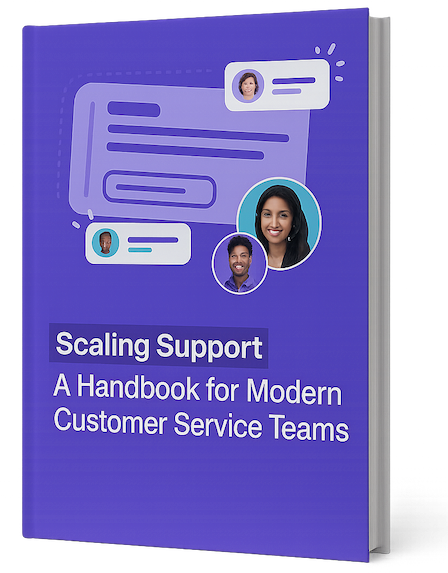What Makes Customer Experience Truly Matter

Real customer experiences show us why delivering great service matters so much. More than half of customers – 52% to be exact – say they'll switch to a competitor after just one bad experience. Beyond just losing a single sale, this means potentially losing a customer for life. Today's customers expect more than basic service – they want meaningful interactions that make them want to come back.
The True Cost of Poor Customer Experiences
Bad customer experiences have ripple effects far beyond one lost sale. When customers feel let down, they share those experiences with others, making it harder and more expensive to attract new business. The numbers paint a clear picture – 49% of customers who left a brand last year did so because of poor service. Like dropping a stone in a pond, one negative interaction can drive away many potential customers before they even give you a chance.
The financial toll is staggering – U.S. companies lose $1.6 trillion each year when customers switch brands due to poor service. This lost revenue could be reinvested to improve customer experience and drive growth. For businesses, great service isn't optional – it's essential for survival and success.
The Power of Positive Customer Experience Examples
The flip side shows the incredible potential of great service. Customers who've had excellent experiences spend 140% more compared to those with negative ones. This shows the real financial returns of putting customers first. Just like compound interest grows your savings over time, positive customer experiences compound into greater lifetime value.
Building a Loyal Customer Base Through Personalization and Immediacy
Personal touches and quick responses are key for keeping customers coming back. An impressive 88% of online shoppers say they're more likely to return to sites offering personalized experiences. Think of it like having a skilled salesperson who remembers your preferences and anticipates what you need.
Speed also matters more than ever – 72% of customers now expect instant support. This means businesses must be ready to help right away when customers need them. Just as we've come to expect instant results in other areas of life, customers want quick solutions when they reach out for help.
In conclusion, delivering exceptional customer experiences is now make-or-break for business success. The data clearly shows that both positive and negative interactions significantly impact loyalty, revenue, and reputation. By learning from real examples and putting effective strategies in place, businesses can build lasting customer relationships and sustain long-term growth.
Breaking Down Real-Time Response Excellence

Great customer experiences directly impact business growth. But what makes leading companies stand out when it comes to immediate support? It goes beyond just fast responses – successful companies focus on creating genuine, efficient interactions that really connect with customers. With 72% of people now expecting instant support, providing excellent real-time responses has become essential for any business.
Blending AI and Human Touch for Authentic Interactions
One powerful way to deliver great customer experiences is by thoughtfully combining AI tools with human support agents. AI can efficiently handle basic questions and provide quick responses, which frees up human team members to focus on more complex customer needs. The key is maintaining personal connections – for example, programming chatbots to use caring language and make personalized suggestions based on customer data. This approach lets companies deliver both speed and authenticity in their support.
Training for High-Pressure Situations: Empowering Your Team
Just as pilots practice emergency scenarios in simulators, customer service teams need proper training to handle challenging interactions effectively. This means equipping them with knowledge and skills to solve problems quickly while staying composed and empathetic. Having clear communication guidelines and easy access to resources helps teams manage stress and maintain high service levels, even during busy periods.
Scaling Support Operations Without Sacrificing Quality
As companies grow, they must expand support operations while maintaining service excellence. Smart automation tools play a key role here. For instance, platforms like SupportMan can connect customer feedback directly to Slack, letting teams promptly address negative feedback and discuss ratings together. Regular performance reviews and ongoing training help maintain consistent, high-quality support across the team. This reliable, excellent service builds lasting customer loyalty.
Practical Frameworks for Reduced Response Times and Increased Satisfaction
The goal of real-time response excellence is creating happy customers. This requires both quick responses and effectively solving customer issues. Using practical tools like service level agreements (SLAs) and customer relationship management (CRM) systems helps track performance and identify areas to improve. When companies consistently deliver fast, effective support, they show their commitment to customer satisfaction and develop strong, lasting relationships. Combined with the strategies above, this creates a complete approach to delivering excellent customer experiences.
Mastering the Art of Personal Connection

Creating real connections with customers requires more than adding their name to an email. The best companies deeply understand individual preferences and needs to deliver experiences that make customers feel valued. Let's explore how leading brands build meaningful relationships through personalization.
Beyond the Name Game: Understanding True Personalization
While using a customer's name shows basic recognition, genuine personalization goes much deeper. Smart companies analyze purchase history, browsing patterns, and stated preferences to anticipate needs and suggest relevant offerings. For example, clothing retailers recommend complementary pieces based on past purchases, while streaming services suggest movies aligned with viewing habits. This level of personalization shows customers you understand them as individuals, not just entries in a database. When done well, this builds engagement naturally and keeps customers coming back.
Smart Segmentation: Reaching the Right Customer at the Right Time
Not all customers are alike, which is why effective segmentation is crucial. By grouping customers based on shared traits like demographics, buying patterns and lifecycle stage, companies can craft messages that resonate with each segment. A retail business might create distinct email campaigns for first-time versus repeat buyers, or tailor promotions by age group to match generational preferences. Think of it like a restaurant chef who adapts dishes to different diners' tastes. This targeted approach ensures communications feel relevant and timely.
The Personalized Journey: Creating a Natural and Seamless Experience
A truly personalized experience adapts at every interaction point – from initial website visit through post-purchase support. This could mean showing product recommendations based on browsing history, sending customized offers, or providing proactive help informed by past contacts. The key is making personalization feel helpful rather than intrusive. Companies must be clear about data usage and give customers control over privacy. Research shows 88% of shoppers are more likely to return to sites offering personalized experiences, but only when built on trust. Like a good friend who's supportive without overstepping, personalization works best when it enhances naturally without feeling forced.
Scaling Personalization: Maintaining Authenticity and Managing Privacy
As companies grow, maintaining personalized service becomes more complex. The challenge is automating personalization without losing authenticity. Many businesses use AI tools to analyze customer data and generate tailored recommendations. At the same time, they must handle data responsibly and be transparent about collection and usage practices. When companies are upfront about privacy and data practices, customers feel more comfortable sharing information. This balance of automation and trust creates sustainable personalization that can grow alongside the business while keeping customer relationships strong.
Building Seamless Cross-Channel Experiences

Customers now interact with businesses across multiple channels throughout their journey. Someone might first see a product on Instagram, research it on the company website, compare prices using a mobile app, and finally make their purchase in a physical store. This multi-channel approach means companies must deliver consistent, friction-free experiences at every touchpoint. Research shows that 79% of customers expect consistent interactions regardless of how they engage with a business. Let's explore how leading companies create unified customer experiences across all their channels.
Breaking Down Silos and Unifying the Customer Journey
Internal silos often create the biggest roadblocks to delivering seamless customer experiences. When different departments like marketing, sales, and customer service operate independently with limited communication, it leads to disconnected and confusing customer interactions. For example, a customer might get conflicting information from a sales rep versus a support agent. To fix this, companies need to establish clear communication channels between teams, align everyone around shared goals, and implement unified data systems that give all departments access to the same customer information.
Maintaining Message Consistency Across Platforms
Brand consistency is just as crucial as internal alignment. Your messaging, branding and tone should stay consistent whether customers interact with you on your website, social media, or in person. For instance, if a luxury brand uses casual language on social media but maintains a formal tone on their website, this disconnect can damage their reputation and erode customer trust. By maintaining a unified voice across all platforms, you create a cohesive experience that builds customer confidence.
Ensuring Seamless Data Flow Between Channels
Quality customer data enables personalized experiences, but this information often sits in disconnected systems. True seamlessness requires customer data to flow smoothly between all touchpoints, from website visits to in-store purchases. When your systems are integrated, you can track customer interactions across channels to personalize experiences and provide proactive support. For example, if someone abandons their online shopping cart, integrated data lets you follow up with a helpful reminder email. Research shows 71% of B2B customers use multiple channels during purchases, making this integrated approach essential. The goal is eliminating friction points – like customers having to repeatedly explain their issue to different representatives – to create smooth, satisfying experiences at every step.
Converting Customer Feedback Into Growth
Smart companies know that customer feedback is fuel for growth. Rather than seeing complaints as problems to manage, they use feedback to improve their products and build stronger relationships. By addressing issues head-on and making changes based on what customers actually need, these businesses create loyal fans while boosting their bottom line.
Collecting Actionable Feedback: More Than Just Surveys
While surveys provide good insights, getting truly actionable feedback requires multiple channels working together. Social media conversations show real-time sentiment and emerging needs. Post-interaction emails catch specific pain points in the customer journey. Review sites reveal broader patterns. Support tickets highlight recurring issues. By gathering feedback across these different touchpoints, companies build a complete picture of what customers want and need. This comprehensive view leads to more informed decisions about improvements.
Effective Response Protocols: Closing the Feedback Loop
Simply collecting feedback isn't enough – you need a system for acting on it. Great companies respond quickly to both positive and negative feedback to show customers they're listening. This means personally following up on critical issues, publicly acknowledging praise, and proactively reaching out when problems arise. Tools like SupportMan help by routing feedback directly to response teams through platforms like Slack, enabling fast collaborative fixes. When customers see their input driving real changes, it builds trust and community.
Tracking the Impact of Changes: Measuring What Matters
After implementing changes based on feedback, measuring results is crucial. Key metrics like customer satisfaction scores (CSAT), customer effort score (CES), and Net Promoter Score (NPS) show if fixes are working. For example, if CSAT improves after addressing a common complaint, you know you're on the right track. Regular measurement helps teams refine solutions and prove the business value of listening to customers.
Building a Customer-Centric Culture: From Top to Bottom
Creating real change through feedback requires buy-in at every level. The most successful companies empower all employees to gather and act on customer insights. This might mean discussing feedback in team meetings, training staff on complaint handling, or rewarding employees who spot improvement opportunities. When the whole organization focuses on serving customers better, feedback becomes a powerful tool for growth. Companies that commit to this approach see stronger relationships, increased sales, and better brand reputation over time.
Measuring What Actually Matters in CX
Strong customer experiences drive business success, but many companies track the wrong metrics. Simply looking at overall satisfaction doesn't give you the complete picture needed to make meaningful improvements. To build a winning CX strategy, you need to focus on metrics that predict customer behavior and show clear business impact.
Key Metrics That Drive Business Growth
While satisfaction scores provide a starting point, focusing on these key metrics reveals deeper customer insights:
- Customer Effort Score (CES): Measures how easy it is for customers to accomplish their goals with your product or service. High effort often signals friction points that lead to customer churn. For example, if customers struggle with a complicated return process, this shows up in an elevated CES.
- Net Promoter Score (NPS): Reveals whether customers value your brand enough to recommend it to others. NPS functions like a word-of-mouth barometer – strong scores mean customers actively champion your business.
- Customer Churn Rate: Tracks the percentage of customers who stop using your service over time. Since keeping existing customers costs much less than acquiring new ones, high churn points to fundamental issues that need addressing.
- Customer Lifetime Value (CLTV): Shows the total expected revenue from a customer relationship. Understanding CLTV helps you focus resources on your most valuable customers. It's similar to smart investing – nurturing high-value relationships compounds returns over time.
Building a Comprehensive Measurement System
While each metric provides valuable insights, looking at them in isolation gives an incomplete view. Instead, create a measurement system that captures the full customer journey, from first contact through ongoing support. This means combining hard metrics like CES with qualitative feedback from surveys and reviews. Like a doctor evaluating symptoms together, this comprehensive approach reveals patterns and identifies specific areas needing attention.
Using Data to Drive Continuous Improvement
Collecting metrics is only the beginning – the real value comes from acting on those insights to make meaningful improvements. For instance, if NPS drops after launching a new feature, investigate why and adjust accordingly. Tools like SupportMan help by connecting customer feedback directly to Slack, enabling quick team responses. This creates a virtuous cycle where customer insights consistently translate into better experiences. By tracking and responding to the right metrics over time, CX becomes a reliable engine for sustained growth.
Ready to strengthen your customer experience and boost growth? Start your free trial of SupportMan today to see how integrating customer feedback with Slack can help your team deliver outstanding service that keeps customers coming back.


